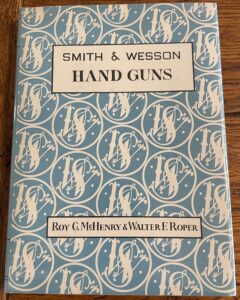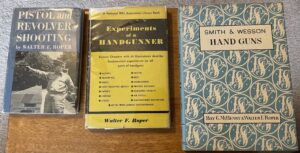Another batch of books is icumen in, so time for some more documentation. I’m happy about this first one, as it fills a much needed void in my collection.

Smith and Wesson Hand Guns, Roy C. McHenry and Walter F. Roper. Standard Publications, 1945. As far as I can tell, this is a first printing. Riling 2527.
This was the first book that attempted to comprehensively cover S&W history (up through about 1944), and remains an important work for collectors.
I can’t find a flaw in this. I’d call it “fine”. Bought for just under $60 from a eBay vendor.
My Ropers, let me show them to you:

These are all (as far as I can tell) firsts of all three books Walter Roper wrote or co-wrote. They’re not quite three of a perfect pair, as the Experiments has a bit of wear. But I’ve still never found another first in the wild in a better state.
(Previously on Pistol and Revolver Shooting. Previously on Experiments of a Handgunner.)
After the jump, another small curiosity…
(more…)

